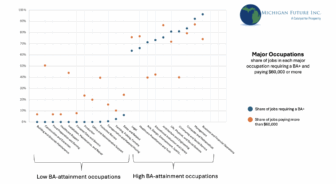The economy is opening back up again and many of us are looking forward to the day when the pandemic comes fully under control and we can resume our “normal” lives. A day when we can honestly say that everything’s going to fine. After all, our favorite restaurants are open. We can even go back to Disney World. But here is the reality. Everything is not fine and it wasn’t fine before any of us ever heard the words Covid-19 or Corona Virus.
Before the pandemic, almost 38% of us were unable to pay for basic needs like housing, food, childcare and transportation according to the Michigan Association of United Ways ALICE data. That number includes almost one million children who are growing up in households with limited opportunities and often going to bed hungry. It’s not an issue of working hard for a solid day’s wages. Michigan has too many low-paying jobs with almost 59% paying less than it takes to reach the middle class for a three person household. It’s limiting our kids’ potential and part of the reason we are losing population as families leave our state for better paying work.
At Michigan Future, we believe that there are structural issues in our economy that will take bold and transformative action to mitigate the impact of growing up in poverty and address the labor shortage that is strangling our recovery, particularly for the small businesses that fuel our communities. The labor shortage poses a very real risk to small businesses in particular, many closing or limiting hours because they simply don’t have the workers to operate normally. It is time for Michigan to step up with a large expansion of the Earned Income Tax Credit (EITC). Now.
We are not alone in calling for an expanded EITC. Republicans and Democrats alike are advocating the use of the EITC to help decrease poverty. An op-ed published last month in The Hill written by Kevin Seifert, a former staff member to Former Republican Speaker of the House, Paul Ryan advocates for a substantial increase in the EITC to cut poverty in America. We agree.
According to the CDC, the EITC has kept more children living above the poverty line than any other program in our history. And it’s more than that. The EITC rewards work and has a proven track record of incentivizing people back into the workforce.
Recent jobs data suggests that nationally we have almost two million more jobs than we do workers actively seeking them. There are a lot of reasons for that in Michigan including a lack of jobs paying livable wages but disproportionately the people not returning to workforce are women. Often they are caring for children with no available childcare or a loved one at particular high-risk in the pandemic. An increase in the EITC will provide a powerful motivator and adequate resources to help with these hurdles.
Who usually gets the EITC? The typical recipient is a single mother in her early thirties with a high school diploma and fewer than two children. That’s who we are talking about. Evidence consistently suggests that an expanded EITC leads to higher employment rates. According to the National Bureau of Economic Research, (NBER.org) almost 60% of the increased employment of single moms between 1984-1996 can be attributed to the EITC. We have a road map for this.
The Michigan legislature and governor are currently evaluating how to appropriate the billions of dollars of funding from the American Rescue Plan Act (ARPA) and a general fund surplus. Michigan has the opportunity to turn the curve in our steadily rising poverty rates with a major investment of our ARPA dollars. Rather than funding hundreds of programs with discreet impact, let’s invest $1 billion a year and increase the EITC to 60%. This will take the existing benefit from $150 a year to almost $1500. An amount that will make a real difference to working families.
We learned from the rounds of stimulus payments, low-income workers use the money for important stuff like food, education and child care. It enables work and goes right back into our economy, fueling future growth. It’s time to be bold and plan for the long road to an economy that benefits everyone.







